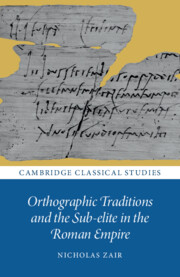Appendix <uo> and <uu> in Catullus
In Chapter 8 I have collected epigraphic evidence for an earlier development of /uɔ/ to /uu/ (around the beginning of the first century BC) than of /wɔ/ and /kwɔ/ to /wu/ and /kwu/ (around the middle of the first century BC). A possible non-epigraphical source of supporting evidence for this is the spelling of these sequences in the poems of Catullus, who was writing in the 50s BC.Footnote 1 The key early manuscripts of Catullus from the fourteenth century are the Oxoniensis (O = Oxford, Bodleian Libraries, MS Canon. class. lat. 30), Sangermanensis (G = Paris, Bibliothèque Nationale de France, MS lat. 14137) and Romanus (R = Vatican City, Biblioteca Apostolica Vaticana, MS Ottob. lat. 1829). The non-extant manuscript from which G and R were copied is known as X, and the manuscript, thought to be in Verona around AD 1300, from which both O and X descend is called V.Footnote 2 There is also a much earlier manuscript, the Codex Thuaneus (T = Paris, Bibliothèque Nationale de France, MS lat. 8071), of the ninth century AD, which contains only poem 62 (on all of this see Reference ThomsonThomson 2003: 23–38; Reference Kiss and KissKiss 2015; Reference Oakley, Quesnay and WoodmanOakley 2021). For the manuscript readings, I use Reference ThomsonThomson (2003), who normally prints <uu> for both /wu/ and /kwu/, and /uu/, and does not note spellings with <uo> in the apparatus unless there is some other variant textual feature, but mentions Caluos (53.3) and nouos (61.54) in the commentary on the latter.Footnote 3 The edition of Reference MynorsMynors (1958) does generally print the spelling <uo> where this can be found or conjectured in OGR or T, and thus provides one additional case, equos at 66.54.Footnote 4
In Catullus’ poetry there are 44 instances of /wu/ and /kwu/, of which 4 are spelt <uo> in all of O, G and R (and hence in V); a further 5 are printed by Mynors on the basis either of one of the principal manuscripts or of highly plausible conjectures. In addition, a spelling seruos also lies behind 23.1 seruus, as noted by Reference ThomsonThomson (2003: 262). By comparison, of 39 instances of /uu/, there is only evidence of 2 instances which may have been spelt <uo> (both conjectures, although highly plausible ones). See Table 46 for all the examples. This distinction, between 10/44 <uo> and <quo> spellings for /wu/ and /kwu/ and 2/39 <uo> spellings for /uu/, is statistically significant.Footnote 5
Table 46 Possible cases of <uo> and <quo> in the archetype of Catullus
If the greater frequency of <uo> spellings for /wu/ and /kwu/ reflects the spelling of Catullus himself (which is of course not certain), it could result from the fact that the <uu> spelling for /uu/ was better established at the time he was writing than <uu> and <quu> for /wu/ and /kwu/, the latter having only just developed from /wɔ/ and /kwɔ/. Alternatively, it is possible that Catullus wrote <uo> both for /wu/ and /kwu/, and for /uu/, and the divergence in the spelling reflects the earlier loss of the spelling <uo> for /uu/ than for /wu/ and /kwu/. That is, copyists were more likely to replace <uo> with <uu> when it represented /uu/, since <uo> for /uu/ became uncommon relatively early, whereas <uo> for /wu/ and /kwu/ was maintained for much longer.
1 It would of course be interesting to see if the pattern identified below was true for other Classical authors. I have restricted myself to Catullus partly because of the fairly short amount of text, and partly because of the relatively restricted apparatus, as well as the availability, in Reference MynorsMynors (1958), of an edition which prints <uo> spellings when these are justifiably to be found in the predecessor of the earliest manuscripts (V). V also contained other optional spellings discussed in this book, in the form of <k> for /k/ in karum (2.6) and <ei> for /iː/ in Furei for Furī (23.1; not included in Reference ThomsonThomson’s 2003 apparatus), mei for mī (27.3), and probably also in a number of cases where textual corruption can be explained by confusion caused by original <ei>, such as ne (6.2 and 14.1) for nī, and tauri et for taurī (63.10). As shown in Chapters 12 and 3 respectively, both <k> before /a(ː)/, and <ei> for /iː/ continued to be used after Catullus was writing (and for many centuries in the case of <k>, especially in the word cārus).
2 Some scholars think that O and X are derived from a copy (known as A) of V, a manuscript thought to be in Verona around AD 1300 (Reference Kiss and KissKiss 2015: xviii). If correct, this has no consequences for the textual criticism of the poems.
3 Curiously, he does print diuolso at 64.257, and uolturium at 68.124.
4 That this spelling is in V is confirmed by the apparatus at Catullus Online (www.catullusonline.org/CatullusOnline/?dir=poems&w_apparatus=1, accessed 25/07/2022), along with digital images of the manuscripts. However, OGR have uult for Mynors’ uolt at 8.9 (I am grateful to Stephen Oakley for pointing this out to me).
5 A Fisher exact test gives a p-value of 0.0293 for these figures, i.e. the difference between the rates is significant at p ≤ 0.05. The test was carried out using the Easy Fisher Exact Test Calculator at Social Science Statistics (www.socscistatistics.com/tests/fisher/default2.aspx, accessed 25/07/2022).



